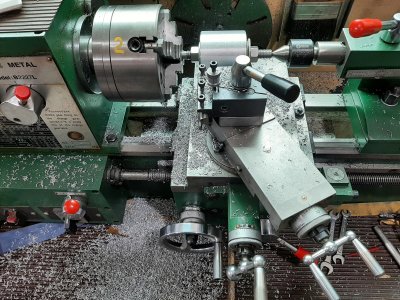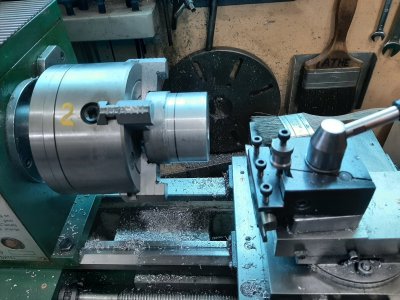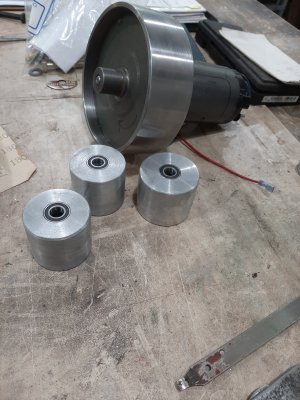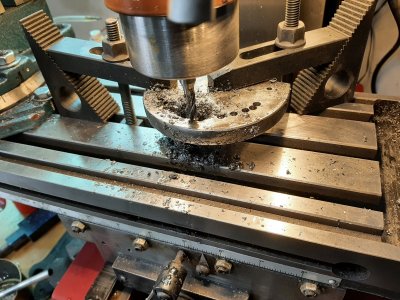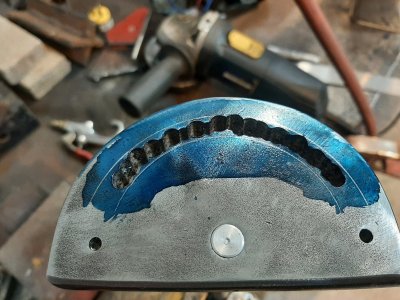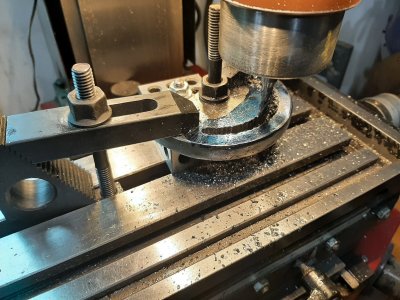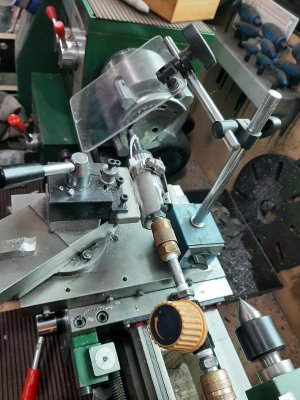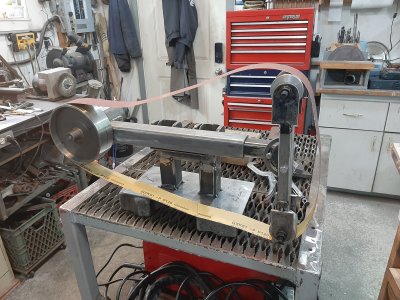nice, but wow on price...4600 US$! I'd love to make one, but just don't know when I'll get to it. I started another project today, top to bottom reconditioning of a very beat up Schaublin 70. Like I need another project, but I've a promised trade pending so had to...and its a train wreck that needs everything. I'll keep the want of a belt grinder in mind and see if serendipity or the universe can work its magic 
-
Scam Alert. Members are reminded to NOT send money to buy anything. Don't buy things remote and have it shipped - go get it yourself, pay in person, and take your equipment with you. Scammers have burned people on this forum. Urgency, secrecy, excuses, selling for friend, newish members, FUD, are RED FLAGS. A video conference call is not adequate assurance. Face to face interactions are required. Please report suspicions to the forum admins. Stay Safe - anyone can get scammed.
-
Several Regions have held meetups already, but others are being planned or are evaluating the interest. The Calgary Area Meetup is set for Saturday July 12th at 10am. The signup thread is here! Arbutus has also explored interest in a Fraser Valley meetup but it seems members either missed his thread or had other plans. Let him know if you are interested in a meetup later in the year by posting here! Slowpoke is trying to pull together an Ottawa area meetup later this summer. No date has been selected yet, so let him know if you are interested here! We are not aware of any other meetups being planned this year. If you are interested in doing something in your area, let everyone know and make it happen! Meetups are a great way to make new machining friends and get hands on help in your area. Don’t be shy, sign up and come, or plan your own meetup!
You are using an out of date browser. It may not display this or other websites correctly.
You should upgrade or use an alternative browser.
You should upgrade or use an alternative browser.
2x72 sander
- Thread starter ShawnR
- Start date
Yea, kind of insane, eh? Some say why need one at all, some say a few features would be nice like tilting belt or table and some say gotta have the Reeder. Each to our own. I think a simple one would have been great for me but I wanted the project and to see what I would do with it, hence the adventure to make a "better mousetrap". It has also been the catalyst to finish the furnace to pour the wheels and now looks like it is becoming a FreeCAD adventure too. And learning lots else along the way so all good.
Gotta admit, had to google "Schaublin 70"...that looks like a rewarding project! Trumps the sander....
Cheers,
Gotta admit, had to google "Schaublin 70"...that looks like a rewarding project! Trumps the sander....
Cheers,
The different wheel sizes are nice to have, but I would only do that if the wheels are rubber coated; bare aluminum isn't great to grind hard materials on so you probably won't use them much. Stick to the same diameter wheels if your wheels are bare aluminum, because it will simplify your build. Also, I would reconsider building an adjustable platen. Please see attached photos of my platens.
W.
I see you answered my question in post 64.
I see you answered my question in post 64.
If you are not grinding on the platen wheels very much or using different size wheels on your platen, then you may only want to build in enough adjustability so that you can square the platen to a grinding rest or table.
Ran across this today @ShawnR
Nice build here. Perhaps some ideas for you. Like you need more inputs
lol....input is good! I started watching both those before but never finished. I just looked at the design and finished project, and, well, you know....
But as my sander evolves, nice to see that some of the things I am doing or adopting (cause I don't recall where I saw it) are incorporated into that design. I ordered those pressure tubes yesterday to use instead of a spring. Today I was bent on changing the position of my wheel. I cut off the motor mount previously mounted and started looking at it in line with the platen main tube and platen, offsetting the motor more. I could hardly wait to get to the shop and try it out......But then, after cutting the motor mount free (only a few tacks) I saw some disadvantages to that and put it back where it was. When I get a little more done, I will post some photos. I am still fumbling around.
Yes, having never used one, I was not aware of the dust/grind that it produces. Goes hand in hand with the rapid material removal that they are popular for I guess. No surprise there. The dust shield Vanderlay is really nice. Definitely something to consider.
Vanderlay does some nice projects and videos. He does a power feed mod to his mill, which is the same mill I have, that has me ....planning.....
Thanks!
Cheers,
Made a bit of progress and a bit of learning in the last week or so. I made a mandrel and turned the first wheel, thinking I needed the mandrel, but have since decided that, although I think it might be the best way to do it, it might not be necessary for this project. Reducing the stock and turning it around seemed to work ok, for me. I put the wheels on the shafts and spun them by hand and they seem to have very little eccentricity (is that a word?)
So all the wheels are done. I probably should have saved the job for the new lathe but wanted to get this step done to move on. Completing the platen is next. It is mostly done as well. Now that the wheels are done, I can position the wheel brackets and tack weld in to place. I can then figure out the mounting brackets for the platen to the chassis. The wheels have a little porosity. Certainly not beautiful aluminum but I am ok with it considering it was my first time melting and pouring/casting aluminum so it is kind of a novelty for me. I think I mentioned earlier in this thread, they feel better than they look. Should work fine.
So all the wheels are done. I probably should have saved the job for the new lathe but wanted to get this step done to move on. Completing the platen is next. It is mostly done as well. Now that the wheels are done, I can position the wheel brackets and tack weld in to place. I can then figure out the mounting brackets for the platen to the chassis. The wheels have a little porosity. Certainly not beautiful aluminum but I am ok with it considering it was my first time melting and pouring/casting aluminum so it is kind of a novelty for me. I think I mentioned earlier in this thread, they feel better than they look. Should work fine.
Attachments
After posting this, I am thinking that a tool grinder with an end mill mounted in the tool post on the lathe. Then the material in the 4 jaw or on a faceplate. Off to explore...
What is it that you need to do to that piece?
RobinHood
Ultra Member
Drill and ream a ”fixtuing hole” at the center of the arc. Mount a corresponding pin vertically to your table. Slip the piece over the pin - now it will pivot around the pin. Move in either x or y the required radius amount. Clamp the part, drill a hole, undo clamp, move part a bit, clamp, drill, repeat until you are done your arc. Use an end mill to clean up the slot.
What is it that you need to do to that piece?
Cut an arc in it. The part is the bracket that secures the grinding belt when you rotate it from vertical to horizontal or any angle in between. I just need to cut an slot for the bolt.
Drill and ream a ”fixtuing hole” at the center of the arc. Mount a corresponding pin vertically to your table. Slip the piece over the pin - now it will pivot around the pin. Move in either x or y the required radius amount. Clamp the part, drill a hole, undo clamp, move part a bit, clamp, drill, repeat until you are done your arc. Use an end mill to clean up the slot.
I had that kind of set up but was considering (briefly) trying to rotate the part by hand. Securing it between cuts would have been better than what I did, which was to adjust the xy each time. Now I am at the file file file stage but almost done. Thanks. I will know for next time.
I think the lathe idea would have worked but all I had in a 1/4" shank was a carbide burr. If I had a 1/4" mill that fit in my die grinder, it might have worked with light cuts.
Attachments
Doggggboy
Ultra Member
Lacking both a mill and a lathe, and for that matter any basic machining skill, I did mine the old fashioned way with the drill press and a carbide burr in the die grinder. Clean up with a file and you're gold.
On my build at least the curved slot is not a critical dimension as long as it clears the clinch bolt and allows for the rotation of the platen.
But yours is going to be better looking for sure
On my build at least the curved slot is not a critical dimension as long as it clears the clinch bolt and allows for the rotation of the platen.
But yours is going to be better looking for sure
Lacking both a mill and a lathe, and for that matter any basic machining skill, I did mine the old fashioned way with the drill press and a carbide burr in the die grinder. Clean up with a file and you're gold.
On my build at least the curved slot is not a critical dimension as long as it clears the clinch bolt and allows for the rotation of the platen.
But yours is going to be better looking for sure
lol...thanks but doubt mine is better looking. That is what heavy coats of tremclad is for! However, it did work out ok. I mentioned the part today was for the main belt part but is actually for the platen. The contraption is starting to look like a belt sander. I realized that when I made the platen up, I did not think about the height above the bench so I will need to add feet to the bottom of the base. The lower wheel contacts the bench (just) so I need to elevate the whole thing an inch or so....
Attachments
Last edited:
Doggggboy
Ultra Member
Yours looks great!lol...thanks but doubt mine is better looking. That is what heavy coats of tremclad is for! However, it did work out ok. I mentioned the part today was for the main belt part but is actually for the platen. The contraption is starting to look like a belt sander. I realized that when I made the platen up, I did not think about the height above the bench so I will need to add feet to the bottom of the base. The lower wheel contacts the bench (just) so I need to elevate the whole thing an inch or so....
Will your drive wheel be doing double duty as a contact wheel? I'm not sure if that is even a thing but it looks doable.
You are freestyling much more than I am. I bought the House Works plans for the Revolution grinder. So far so good.
The only change I made was to use a treadmill motor rather than 3 phase. I know he says a treadmill motor will suck in the grinding dust and die sooner but I have a free one and am starting there. I lucked out on the motor and found that it has a 5/8ths keyed shaft rather than the standard threaded shaft for treadmills. The wheel kit I bought from Nexus Grinders has a 5/8 drive wheel hub. Sweet.
I also found that a 36 grit ceramic belt will remove your fingertips just by taking it out of the box. Ouch! Made cutting up habaneros for supper not pleasant at all.
I still have to make the platen and the platen mounts and the work table but it is inching along with the help of my HS & G mill, (hacksaw and grinder)
Yours looks great!
Will your drive wheel be doing double duty as a contact wheel? I'm not sure if that is even a thing but it looks doable.
You are freestyling much more than I am. I bought the House Works plans for the Revolution grinder. So far so good.
The only change I made was to use a treadmill motor rather than 3 phase. I know he says a treadmill motor will suck in the grinding dust and die sooner but I have a free one and am starting there. I lucked out on the motor and found that it has a 5/8ths keyed shaft rather than the standard threaded shaft for treadmills. The wheel kit I bought from Nexus Grinders has a 5/8 drive wheel hub. Sweet.
I also found that a 36 grit ceramic belt will remove your fingertips just by taking it out of the box. Ouch! Made cutting up habaneros for supper not pleasant at all.
I still have to make the platen and the platen mounts and the work table but it is inching along with the help of my HS & G mill, (hacksaw and grinder)
Ours look very similar from a glance. Yours looks heavier duty. I am wondering if mine will be solid enough. I am trying not to over build it but hopefully, I don't make it too light. We are both using treadmill motors too. Cool! No, I don't plan on using the drive wheel for a contact wheel. It is crowned and it seems wrong to me...don't know why. I am working on the tensioning mechanism today. Almost have it done, I think. My motor had to go on the other side due to its direction of rotation and left hand threads holding the wheel on. With yours being keyed, it does not matter I guess as you can switch the power leads. As for dust, I think some good filter material around the air intake will take care of that. If you have an extra set of leads coming out of the motor, I believe they are for an over temp sensor. That could be wired into to an indicator as a warning or even a relay and power relay. Nice looking shop. Looks huge!
Cheers,
.
Doggggboy
Ultra Member
The plans for mine called for 1/4 inch wall 2x2 tubing and 1 1/2 inch tubing. I used 3/16 wall for the 1 1/2 as it's all I could find. Seems pretty solid. The base plate is 1/4 and the motor plate and D-plate are 3/8. The 4 pivot plates are 1/2 inch which is serious overkill.Ours look very similar from a glance. Yours looks heavier duty. I am wondering if mine will be solid enough. I am trying not to over build it but hopefully, I don't make it too light. We are both using treadmill motors too. Cool! No, I don't plan on using the drive wheel for a contact wheel. It is crowned and it seems wrong to me...don't know why. I am working on the tensioning mechanism today. Almost have it done, I think. My motor had to go on the other side due to its direction of rotation and left hand threads holding the wheel on. With yours being keyed, it does not matter I guess as you can switch the power leads. As for dust, I think some good filter material around the air intake will take care of that. If you have an extra set of leads coming out of the motor, I believe they are for an over temp sensor. That could be wired into to an indicator as a warning or even a relay and power relay. Nice looking shop. Looks huge!
Cheers,
.
The square tubing gets tapped in a few places so the 1/4 inch thickness holds a thread securely. Platen support plate is supposed to be 1/4 inch with a high carbon steel platen on top. I guess lots of guys are using heat resistant glass for the platen now to avoid wear. I won't be making knives, I don't think, so not sure what I'll use. One Tuber just used regular glass tile and it seemed to hold up for him even making knives but that was a 6 by 48 sander I think.
Yeah, the shop is a blessing and a curse. 30 by 60 with 12 foot walls. It was just bare metal until a few years ago when I treated myself by insulating and finishing the interior, having it wired and heated and putting in a four post lift. It's a nice play to play but I seem to be genetically incapable of keeping it tidy or organized.
My wife and I laugh about it. Her hobby is honeybees and unless you are going to eat 1500 lbs of honey yourself you have to sell it, so she does. She is an all in kinda girl so to sell honey she got CFIA certified and we built a 30 by 30 extraction facility. Because she produces certified safe honey she does well. Makes money even.
My shop is the kinda place that money goes in and is never heard from again
What are you using for motor control?
I use the old control board with a cheap pulse generator from Amazon. Works like a charm.
The plans for mine called for 1/4 inch wall 2x2 tubing and 1 1/2 inch tubing. I used 3/16 wall for the 1 1/2 as it's all I could find. Seems pretty solid. The base plate is 1/4 and the motor plate and D-plate are 3/8. The 4 pivot plates are 1/2 inch which is serious overkill.
The square tubing gets tapped in a few places so the 1/4 inch thickness holds a thread securely. Platen support plate is supposed to be 1/4 inch with a high carbon steel platen on top. I guess lots of guys are using heat resistant glass for the platen now to avoid wear. I won't be making knives, I don't think, so not sure what I'll use. One Tuber just used regular glass tile and it seemed to hold up for him even making knives but that was a 6 by 48 sander I think.
Yeah, the shop is a blessing and a curse. 30 by 60 with 12 foot walls. It was just bare metal until a few years ago when I treated myself by insulating and finishing the interior, having it wired and heated and putting in a four post lift. It's a nice play to play but I seem to be genetically incapable of keeping it tidy or organized.
My wife and I laugh about it. Her hobby is honeybees and unless you are going to eat 1500 lbs of honey yourself you have to sell it, so she does. She is an all in kinda girl so to sell honey she got CFIA certified and we built a 30 by 30 extraction facility. Because she produces certified safe honey she does well. Makes money even.
My shop is the kinda place that money goes in and is never heard from again.
What are you using for motor control?
I use the old control board with a cheap pulse generator from Amazon. Works like a charm.
I used similar tubing only to get the 1.5 sliding nicely within the 2x.025. Other than that, I used whatever else was handy. That is why I did not want to purchase plans. I would deviate anyways so I scaled from pictures on websites to get starting dimensions. It seems to have worked out ok, except for the platen lower wheel being about a 1/4' lower than the base. I am adding feet to the bottom of my base to compensate. My platen surface will be the glass, eventually, probably,...
How long does it take for bees to make 1500 lbs of honey? Is that an annual production? What does an extraction facility look like? Are you in Canada? Your profile says Germany so wondering if you are from there and living here now, or the other way around, or just like hanging out with us Canadians....I could see that....
Cheers,
Doggggboy
Ultra Member
Germany? Lol.I used similar tubing only to get the 1.5 sliding nicely within the 2x.025. Other than that, I used whatever else was handy. That is why I did not want to purchase plans. I would deviate anyways so I scaled from pictures on websites to get starting dimensions. It seems to have worked out ok, except for the platen lower wheel being about a 1/4' lower than the base. I am adding feet to the bottom of my base to compensate. My platen surface will be the glass, eventually, probably,...so I positioned the wheels to give me room to put something in there as a wear surface. Re motor control, I am using the MC60 boards I got from some treadmills. There are some different variations and only one that I have requires a separate PWM circuit. 2 others just require a control. I have the components to make up the circuit as it is pretty simple but I also purchased a small DC Motor control to use as the PWM source. Have not experimented with that yet.
How long does it take for bees to make 1500 lbs of honey? Is that an annual production? What does an extraction facility look like? Are you in Canada? Your profile says Germany so wondering if you are from there and living here now, or the other way around, or just like hanging out with us Canadians....I could see that....
Cheers,
Kronau, Saskatchewan.
Facebook thinks my wife's apiary is in Germany sometimes as well. Drives her crazy.
The honey was just from one year's production from about 10 or 15 hives. Saskatchewan has some of the highest per hive production in the world because of our short but intense growing season where everything flowers at once. That and the oceans of canola.

